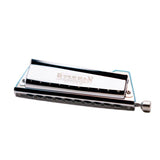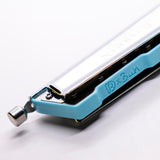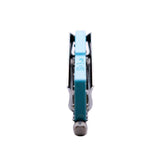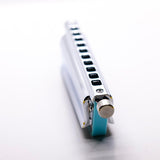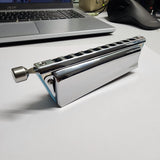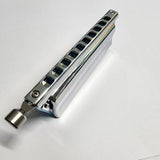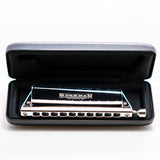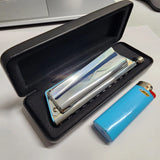Bushman Game Changer. 10 Hole Diatonic Harmonica with Slide. Includes Free USA Shipping
The Richter Blues Game Changer – Richter tuning, also known as Blues tuning, is laid out exactly like a regular, 10-hole diatonic harmonica. It has a slide that raises the note a semitone. The age old challenge for diatonic players has been that if they want to get the sharps and flats (the black keys on a piano) they would have to learn to bend the notes. Well that works great for the blues, or any music where coming in flat or sharp and quickly adjusting to the right pitch actually sounds cool, but if you try that on a song like “Beautiful Dreamer”, for example, not hitting that flat note precisely will sound like a fart in church! And don’t be fooled, even Joe Filisko and Howard Levy need a moment to hear where they’re at on the bend before they’re perfect. The button on the Game Changer eliminates all of that – it allows the player to precisely hit the accidentals. With the Richter Game Changer, an average diatonic player can hit sharps and flats more cleanly and precisely than the best bending harmonica players in the world!
Here is a diagram showing normal Richter tuning:

Before the Game Changer, if you wanted to play chromatically (as in, if you wanted to be able to get all the sharps/flats) you needed to get a chromatic harmonica. The problem for diatonic players is that a chromatic is Solo tuned, meaning the notes are laid out totally differently than a Richter tuned diatonic; so for a diatonic player, learning to play a chromatic is like learning a second language. Furthermore, chromatics take more air than diatonics, AND they’re clumsy and awkward to bend. Chromatic manufacturers try to solve that by adding irritating, plastic wind savers to make the harmonica more air-efficient, but then you can hear the wind savers flapping. Most diatonic players think chromatic harmonicas are real pigs – they take too much air, they fight you on the bends, they’re not as bluesy sounding, and they make flapping noises. The Richter Game Changer solves all of that!
The Game Changer has no wind savers flapping in the wind, it’s the most efficient, easy-responding, easy-bending harmonica I’ve ever played. It’s a diatonic with a button that can get the sharps and flats! It’s a little bigger than a 10 hole diatonic, but it’s much smaller than a chromatic…and it’s easier to play. The Richter Game Changer has a light blue comb.
The Solo Tuned (aka Chromatic) Game Changer – Solo tuning, sometimes called Chromatic tuning, features a note layout that is exactly like any standard chromatic harmonica. The advantages that the Solo Game Changer brings to the market are: Compact, 10 hole size – does any other company even make a 10 hole chromatic anymore? If they do, I bet it’s still not as small as a Game Changer. The small size makes the instrument extra easy to play since it has small, super responsive reeds that don’t require plastic wind savers. It can play as fast as you can! The little Game Changer still offers a two-and-a-half octave range, from C4 to F#6. Lots of chromatics are only available in C or C, A, and maybe G. The Solo Game Changer comes in 6 keys! Chromatics are usually expensive, with the most popular models being over $200; the Solo Game Changer is only $87.50 which is less than the cost of many 10 hole diatonics. If you’re a diatonic player looking to try your hand at a chromatic, I recommend getting the Richter tuning, but if you’re a chromatic player who wants an excellent, fast responding, very affordable, 10 hole chromatic, that is available 6 keys including the rich sounding Low F, I recommend the Solo Game Changer. It has a yellow comb.
Tuning Chart for Solo(Chromatic) Tuning

Tuning Chart for C6 Tuning (Only Comes In Key of C)

The Pop Tuned (aka Paddy) Game Changer – First, let me refer back to the Richter Game Changer’s tuning ‘s which is the standard tuning for most diatonic harmonicas. Richter tuning works great for simple songs and blues. It’s originally designed for playing chords, as opposed to single note melodies.

| Weight | 9 oz |
|---|---|
| Dimensions | 6.5 × 2.375 × 1.25 in |
| Tuning |
Standard Richter , Solo, Paddy |
| Key |
A, Bb, C, D, G, LF |









